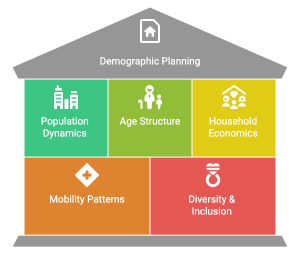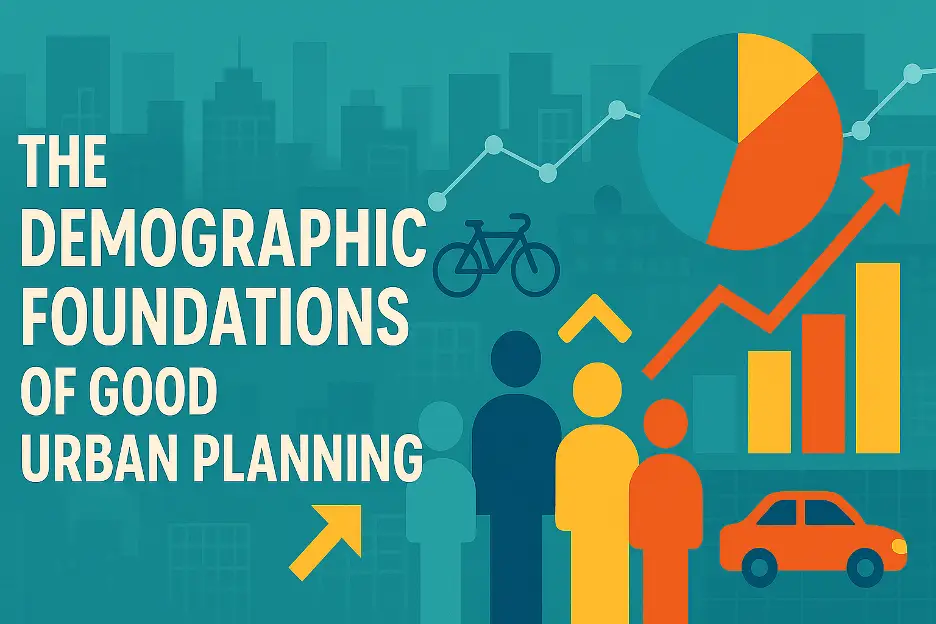The Demographics in Urban Planning: How Population Trends Shape Better Cities
By: Ghulam Mohey-ud-din
Urban planning is ultimately about people – not just about buildings, streets, or land use. Yet too often, urban plans gloss over the demographic analysis that tells who lives in the city, how they live, and what they need. Many plans include only a simplistic population growth chart, with no detailed age profiles, no household or family composition, no income distribution. This is a problem. Robust demographic analysis isn’t a “nice-to-have” – it is fundamental for informed decisions in city planning and for strategies that can stand up to public scrutiny. Planners must ground their proposals in the realities of the population they serve. Below, we explore five key ways that demographics shape cities and why urban planners need to pay close attention to each.

1. Significane of Population Growth Trajectory for Demographics in Urban Planning
Long-range population forecasts often provide multiple scenarios (high, medium, low) to guide planning under uncertainty. Effective urban plans use such demographic projections to align infrastructure and services with future population trajectories.
Births, deaths, and migration are the core drivers of a city’s growth or decline. In demographic terms, populations are never static – they grow or shrink through the interplay of fertility (births), mortality (deaths), and migration[1][2]. The number of people in a city can change rapidly if more people move in or out, or if birth rates and death rates shift significantly. For example, many fast-growing cities in Africa and Asia are booming largely due to high birth rates and rural-to-urban migration, whereas some cities in Eastern Europe are shrinking as a result of low fertility and the emigration of young people[3]. Understanding these dynamics is essential. Planners need to anticipate how population trends will affect infrastructure, housing, and public services in the coming years. As one planning guide notes, selecting a data-driven population forecast is “a fundamental step in the … process” – it informs how much land to zone for housing, how big to build utilities, and where to invest in transportation[4]. Indeed, population projections are the cornerstone of long-range planning efforts[5].
Crucially, planning without a grasp of population trajectory is like designing in the dark. A city growing by 3% per year has vastly different needs than one growing by 0.3% or one declining in population. Overly optimistic forecasts can lead to overbuilt infrastructure that strains budgets, while underestimates can leave a city scrambling with overcrowded schools or traffic-choked roads[6]. Good plans therefore use robust demographic methods (like cohort-component models that factor in births, deaths, and migration) to project future population under various scenarios[7]. These models show, for instance, that all population growth is ultimately influenced by those three factors[8]. By “showing their work” in how they derived population figures, planners create a defensible basis for decisions and can adjust policies if reality diverges from projections[9]. In short, population growth matters: a city’s long-term viability, from its tax base to transit ridership, depends on knowing whether the population will boom, bust, or plateau.
It’s worth noting that global demographic trends are in flux. Today, more than half of the world’s people (over 4 billion) live in cities, and urban populations are expected to double by 2050, by which time nearly 7 in 10 people will live in urban areas[10][11]. But this growth won’t be evenly distributed. Some cities will continue to expand rapidly – especially in developing regions – while others will stagnate or even shrink. “Not all cities will grow endlessly,” as a World Bank report on urban demographics cautions, so today’s investments must account for the demographic reality of tomorrow[12]. In practical terms, this means a city planner must ask: Are we preparing for growth, planning for decline, or both? A forward-looking plan might, for example, phase new infrastructure to match expected population increases, or in the case of decline, focus on rightsizing and revitalization. The bottom line is that without sound population analysis, any urban design or policy could miss the mark by failing to serve the future city’s size and needs.
The above discussion highlights the significane of demographics in urban planning.
2. Age Structure and Lifecycle Needs
Every city’s age profile profoundly influences what services and infrastructure it requires. A city with a rising senior (65+) population will need vastly different amenities than one teeming with young families or children. For instance, a community with a large percentage of residents under age 15 implies the need for ample schools, playgrounds, maternity clinics and family health services[13]. In contrast, an aging city – where a growing share of residents are elderly – must invest in accessible healthcare facilities, senior centers, assisted living options, and age-friendly public spaces. Planners must study the changing composition of the population because the age of residents is closely tied to demand for services[14][13]. Simply put, age structure determines a city’s service footprint: Are we building more kindergartens or more nursing homes? Do we prioritize youth sports fields or adult day care centers? The answers lie in demographic analysis.
Globally, populations are aging as fertility rates fall and life expectancies rise. By 2050, one in six people in the world will be over age 65 (up from one in eleven in 2019)[15]. Urban areas, especially in developed regions, are on the frontlines of this trend. Many cities in Western Europe, Japan, and North America are already grappling with the needs of a greying population – from retrofitting transit systems with elevators and ramps, to redesigning street crossings for slower walkers. In Eastern Europe and parts of Asia, some cities face a dual challenge of aging and depopulation: for example, cities in Central Asia and the Baltics have seen an exodus of younger workers, leaving behind older residents and accelerating the rise in average age[16][3].
These shifts carry important implications. An aging city might need more healthcare workers per capita, different housing formats (e.g. downsized apartments or assisted living), and “age-friendly” urban design (better lighting, more benches, safer sidewalks). Meanwhile, a city booming with children and young adults has to plan for schools and jobs: enough classroom seats, teacher recruitment, entry-level housing that young workers can afford, and eventually opportunities to form families without leaving the city.
Urban transportation and recreation must also adapt to age demographics. Younger populations tend to be more active physically and socially – they benefit from bike lanes, sports facilities, universities, and nightlife districts. Older populations may prioritize walkability in a different way – safe, accessible walking routes to clinics or shops – and public transport that accommodates limited mobility (low-floor buses, priority seating). A telling example of planning by age structure is how health services are allocated: a city heavy with people in their 20s and 30s might focus on maternity wards and job training centers, whereas one with many over 70 will invest in geriatric care, home-based services, and perhaps fewer schools.
Knowing the age profile and its trajectory (are we getting younger or older as a city?) is thus critical for phasing investments. As one demographic training puts it, knowing the age ranges of residents is of critical importance to planners because it indicates demand for specific services at different life stages[14]. In summary, age is more than just a number for cities – it’s a blueprint for planning a livable community tailored to its inhabitants, whether they are toddlers, teenagers, working-age adults, or pensioners.
3. Housing Needs and Preferences
Housing is perhaps where the rubber meets the road in connecting demographics to urban planning. Who lives in a city – in terms of household size, family composition, and income levels – directly influences what kind of housing is needed. Planners risk severe misalignment if they ignore these demographic insights, potentially ending up with a glut of housing that nobody wants or a shortage of the types that people actually need. Key factors include household size (how many people under one roof), household type (single adults, nuclear families, multigenerational families, etc.), and income distribution (which affects affordability). For example, in many countries, average household sizes have been shrinking for decades due to lower birth rates and more people living alone. On average, households worldwide have decreased by about 0.5 persons per decade over the past half-century[17]. In many major cities today, single-person households account for 30% or more of all households, a dramatic shift toward people living alone[18].
This rise of solo living creates massive demand for smaller housing units – studios, one-bedroom apartments, and innovative options like micro-units or co-living spaces with shared amenities[18]. Planners must ensure zoning and housing strategies accommodate this trend, by permitting higher densities and encouraging a mix of unit sizes (not just family-sized homes). A city full of large three-bedroom houses will be out of sync if a large share of its residents are singles or couples with no kids.
Conversely, multigenerational households are also on the rise in some places. Once mainly associated with certain cultures, multigenerational living (three or more generations under one roof) is becoming more common across demographic groups – in the U.S., nearly 1 in 5 people now live in multigenerational households, double the rate of the 1980s[19]. This trend is driven by economic pressures (housing costs, caregiving needs) and cultural preferences alike.
The planning implications are significant: housing design may need to include flexible layouts, “in-law” suites or accessory dwelling units (ADUs), and larger unit sizes to comfortably accommodate extended families[20]. Some home builders now offer models with dual master suites or semi-independent living areas to meet this demand [20]. Cities like Los Angeles and Portland have even changed zoning laws to more easily allow ADUs or backyard cottages, recognizing the need for adaptive housing forms for larger or extended families[21]. In sum, understanding household composition helps planners align housing supply – in terms of unit types and sizes – with how people actually live together.
Income distribution and cultural background further shape housing preferences. A city with a large low-income population will have strong needs for affordable and subsidized housing; failing to plan for that can lead to housing insecurity or the growth of informal settlements. Indeed, globally over 1 billion urban residents live in slums or informal settlements, largely because formal housing supply does not match the needs or means of lower-income households[22][23]. Inclusive planning means using demographic data (like income quintiles, poverty rates, tenure statistics) to calibrate housing policies – for example, setting targets for affordable units, mixed-income developments, or rental housing if the majority cannot afford homeownership. I
t also means recognizing cultural preferences: in some communities, for instance, there may be preferences for certain housing arrangements (such as courtyards for communal gatherings, or extended family compounds). Planners should engage with diverse groups to understand these nuances. A case in point: a housing project in Minneapolis incorporated adaptable kitchen designs to accommodate cultural cooking practices (in that case, allowing Muslim women to cook more privately if desired)[24]. Such details show how demographic insight (in this case, understanding the cultural norms of a resident group) can inform housing design for greater comfort and inclusion.
Ultimately, getting housing right is a demographic balancing act. Urban planners must ask: What mix of singles vs. families do we have? Are young adults able to find starter homes? Are there enough senior-friendly units as the population ages? Is housing supply keeping up with population growth at various income levels? These questions can only be answered by diving into data on population composition. The reward is a housing strategy that provides the right options – from small downtown apartments to suburban family homes to elder-accessible units – in the right proportions. By aligning housing supply with demographic demand, cities can avoid mismatches that lead to vacant luxury condos on one end or homeless families on the other. In short, demographics are destiny for housing markets, and proactive planners use those insights to ensure everyone has a place to live that suits their needs and means. Thus, the importance demographics in urban planning can not be undermined.
4. Transportation and Mobility Patterns
Mobility patterns in a city reflect its demographics. In many cities, younger residents and commuters embrace walking and public transit, as seen in busy pedestrian districts, while families with children or older adults may rely more on cars. Transportation planning must account for these differences to serve all ages and lifestyles.
How people move around a city is not one-size-fits-all – it varies with age, income, family situation, and more. A robust urban mobility plan therefore needs to consider who is traveling, why they travel, and how their needs differ. For example, younger adults (think students and young professionals) are often more inclined to use public transit, bicycles, and walking than older generations. In recent years, many cities have observed a decline in car ownership and driving among youth. In the United States, between 2001 and 2009 young people (ages 16–34) drove 23% fewer miles per capita, while increasing their use of public transit by 40%[25][26].
This generational shift – attributed to changing preferences, urban living, and economic factors – suggests that a city with a large youth population should invest heavily in transit, cycling infrastructure, and walkable neighborhoods to match their lifestyle. Indeed, surveys find young adults are more enthusiastic about transit and are delaying getting driver’s licenses compared to prior generations[27][28]. Planners can leverage these trends by expanding bus and rail networks, creating safe bike lanes, and supporting car-alternative options (like scooters or ridesharing drop zones) in areas with many youth and students.
On the other hand, older adults and family households often have different mobility needs. Parents shuttling children to school or activities may favor the convenience of cars (especially when carrying groceries, strollers, or multiple kids). Not surprisingly, studies show that car use tends to be higher among households with children than those without[29]. This doesn’t mean families won’t use transit – but transit routes and schedules must be practical for school runs and have space for things like prams. Older adults, particularly the elderly, may eventually reduce driving and rely more on public transport or community shuttles if those services are accessible and senior-friendly.
Planning for an aging population might involve providing more seating and shelters at bus stops, training drivers in assisting passengers with mobility impairments, and improving sidewalk conditions (smooth surfaces, curb cuts) so seniors can safely walk or use mobility aids. In car-dependent cities, older people can become isolated if they outlive their ability to drive, so offering alternatives (paratransit, dial-a-ride vans, etc.) is crucial. In short, inclusive transportation planning means designing a network that works for a 20-year-old college student, a 35-year-old working parent, and a 75-year-old retiree alike.
Demographics also intersect with transportation in terms of commuting patterns and mode choices. For instance, income levels can affect whether people drive or take transit – lower-income residents are more likely to depend on public transport, yet they often face the longest, least convenient commutes if transit is not planned equitably. Planners must consider where different socio-economic groups live and work: Are affordable neighborhoods well-served by transit to major job centers? Are there safe routes for children to walk or bike to school from residential areas? Is the city prepared for a rise in senior drivers (who may drive more slowly) or an influx of teenagers biking?
A comprehensive mobility plan uses demographic data – such as journey-to-work statistics by age/income or license holding rates – to forecast demand on roads and transit. For example, if a city sees that only 50% of its younger millennials have driver’s licenses (versus 70% of older generations)[30], that’s a sign to double down on transit and rideshare infrastructure. Similarly, if a district is attracting many young professionals, one can expect high uptake of cycling and walking; whereas a suburban area with large families might need parking management and school bus services.
Finally, mobility is about more than moving people – it’s about access and equity. Planners should ask: which demographic groups have the most difficulty getting around? Often, it’s the very old, the very young, the disabled, and the poor. Designing “universal” transportation (e.g. low-floor buses, audible crosswalk signals, affordable fares or discounts) helps ensure no group is left stranded. A city’s transportation network effectively knits together its population, so it must reflect the diverse ways people travel. By understanding demographic patterns – who is likely to ride a bike versus drive, who needs transit at off-peak hours, who is transporting children or cannot walk far – planners can create a system that is efficient and inclusive. Whether it’s through youth-oriented transit passes, stroller-friendly trams, or ride services in low-density senior communities, matching mobility options to the population makes the city move better for everyone.
So, the mobility is about moving the people, i.e., demography whihc means demographics in urban planning and transport and mobility planning is very significant.
5. Diversity, Inclusion, and Urban Equity
Cities are melting pots of cultural, ethnic, linguistic, and socio-economic diversity. This diversity profoundly shapes how residents experience the city – and it should shape how planners design the city. Planning that fails to consider these dimensions can inadvertently reinforce exclusion and inequality. Unfortunately, history offers stark examples of urban design being used as a tool of segregation. In mid-20th century New York, for instance, powerful planner Robert Moses infamously built certain parkway bridges too low for buses to pass under – effectively barring low-income and minority people (who relied on public buses) from accessing Long Island’s beach parks[31]. Likewise, many cities implemented zoning and housing policies that separated communities by race or class, creating privileged enclaves and underserved districts. The legacy of such exclusive planning is seen in cities with glaring disparities – where one neighborhood enjoys lush parks and smooth transit, while another (often home to marginalized groups) suffers from poor services and isolation.
Inclusive urban planning aims to correct these wrongs and make cities that work for everyone. An inclusive city, as defined by the “Cities For All” global campaign, is one where all people – regardless of income, gender, ethnicity, age, disability, or religion – can participate fully in the opportunities of urban life[32]. For planners, this means proactively considering the needs of diverse groups in every aspect of the plan. Does the city provide public spaces for everyone – for example, parks that host cultural festivals for different ethnic communities, or community centers that welcome both old and young, native-born and immigrants? Are there multilingual signs and services so that language is not a barrier to accessing city resources? (In a diverse city, something as simple as providing information in the main languages spoken – as Belgium does with French and Dutch on signs[33][34] – can make a big difference in helping immigrants and minority-language speakers feel welcome and navigate safely.)
Inclusive planning also involves safeguarding cultural heritage and landmarks of various groups, supporting minority-owned businesses, and ensuring that all voices are heard in the planning process. This last point is vital: effective plans engage community members across racial and socio-economic lines, so that policies aren’t made only by and for a privileged subset. As one urban scholar puts it, inclusivity in planning is about asking “Who is left out of the picture when planners imagine a city space?” – and then bringing those “others” into the process[35].
The benefits of considering diversity in planning are tangible: it leads to public spaces and policies that are welcoming, equitable, and culturally rich. For example, planners who noticed that in one city Asian-American families were 2.5 times more likely to use parks for large family gatherings and Black residents were 1.75 times more likely to go fishing used this insight to program a big urban park (Phalen Park in St. Paul) with cultural events, a Chinese garden, and varied amenities – resulting in over a million visits a year[36][37]. This demonstrates how data on different groups’ recreational habits can inform design to serve all. Similarly, recognizing diversity in transportation (“Transportation for Different Needs”) has cities rethinking transit routes to better connect low-income or minority neighborhoods to job centers, or adding women-only transit options in areas where women feel unsafe.
Inclusivity also means making sure one group isn’t disproportionately burdened – for instance, ensuring that affordable housing isn’t all concentrated in one corner of the city, or that environmental hazards (like waste facilities) aren’t all placed in minority communities. In short, a planner’s job is to plan for the entire population, in all its variety. As the Congress for New Urbanism notes, this may require shifting perspective: viewing the city as a social system of diverse roles and life phases, rather than a set of technical problems, makes it easier to design for inclusivity[38]. When done right, demographic insight helps create urban environments where public spaces feel open to all cultures, services reach the underserved, and different communities can thrive side by side instead of being siloed.
“Cities have the capability of providing something for everybody, only because, and only when, they are created by everybody.”[39]
This famous observation by urbanist Jane Jacobs encapsulates why sound demographic analysis must lie at the heart of urban planning. A city can only truly be vibrant and sustainable if its planning considers everybody – all ages, incomes, and backgrounds. Numbers and data are the tools that reveal who our “everybody” is. By knowing the population in detail, planners can design for the population, making choices that reflect real needs and promote equity. Ultimately, good urban planning builds on a simple principle: Know your population. Plan for your population.[40][41] When we plan with people in mind – in all their demographic dimensions – we create cities that are not only functional and efficient, but also inclusive, livable, and resilient for generations to come. Thus nobody can deny the importance and usefulness of demographics in urban planning.
Kewords: Demographics in Urban Planning, Demographics, Urbanb Planning, Demography
Sources:
- World Bank – Demographic Trends and Urbanization[42][12]
- MEASURE Evaluation – Population Analysis for Planners[43][13]
- MRSC – Importance of Population Forecasts[4][7]
- World Bank – Urban Development Overview[10][22]
- UN DESA – World Population Prospects 2019 Highlights[15]
- Alliance CGC – How Demographics Shape Real Estate[18][19]
- Public Interest Network – Transportation and the New Generation[25][26]
- Bergstad et al. – Car use and demographics[29]
- Active Sustainability – Inclusive Urban Planning[31][32]
- CNU – New Urbanism is Inclusive Urbanism[38]
- Scholars Strategy Network – Expanding Inclusivity in Planning[35]
- Jane Jacobs, The Death and Life of Great American Cities[39]
[1] [2] [13] [14] [40] [43] Lesson 2: Population Analysis and Planning — MEASURE Evaluation
[3] [12] [16] [42] Demographic Trends and Urbanization
https://www.worldbank.org/en/topic/urbandevelopment/publication/demographic-trends-and-urbanization
[4] [5] [6] [7] [8] [9] MRSC – The Importance of Population Forecasts for your Comprehensive Plan
[10] [11] [22] [23] Urban Development Overview
https://www.worldbank.org/en/topic/urbandevelopment/overview
[15] Ageing – the United Nations
https://www.un.org/en/global-issues/ageing
[17] A global perspective on household size and composition, 1970–2020 | Genus | Full Text
https://genus.springeropen.com/articles/10.1186/s41118-024-00211-6
[18] [19] [20] [21] The Role of Demographics in Shaping Future Real Estate Trends
https://www.alliancecgc.com/real-estate/how-demographic-trends-shape-commercial-real-estate
[24] [33] [34] [36] [37] 10 Ways Cultural Diversity Shapes Urban Planning | Basis Blog
https://basishealth.io/blog/10-ways-cultural-diversity-shapes-urban-planning-policy
[25] [26] Transportation and the New Generation
[27] Generational Trends in Vehicle Ownership and Use: Are Millennials …
https://papers.ssrn.com/sol3/papers.cfm?abstract_id=3360826
[28] [30] [PDF] How General are Generational Trends in Vehicle Ownership and Use?
https://eprints.lse.ac.uk/113646/1/Jarvis_how_generational_are_generational_published.pdf
[29] Car access and travel behaviour among men and women in car …
https://www.sciencedirect.com/science/article/pii/S2590198221000749
[31] [32] From cities that discriminate to cities for everyone: inclusive urban planning
https://www.activesustainability.com/construction-and-urban-development/urban-planning-inclusive/
[35] [41] Expanding the Concept of Inclusivity to Meet Contemporary Urban Planning Needs | Scholars Strategy Network
https://scholars.org/contribution/expanding-concept-inclusivity-meet
[38] New Urbanism is inclusive urbanism | CNU
https://www.cnu.org/publicsquare/2024/03/25/new-urbanism-inclusive-urbanism
[39] Jane Jacobs










Leave a Reply